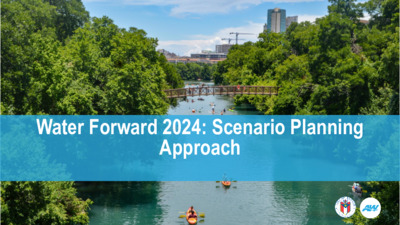Backup — original pdf
Backup

Water Forward 2024: Scenario Planning Approach Drivers from Water Forward 18 Clearer approach to water needs identification More robust approach to addressing risk and uncertainty Development of a more comprehensive adaptive management plan Planning for plausibility vs. probability • Uncertain parameters cannot be predicted or well understood using standard statistical methods Predicting the most likely future or creating a plan that performs best on average vs. Finding robust strategies that perform well across a wide range of plausible futures, or scenarios Strategies perform well against “most likely” future conditions Strategies perform well across range of possible scenarios https://www.r-bloggers.com/2014/10/my-commonly-done-ggplot2-graphs/ Planning for Uncertainty in WF24 ▪ Develop a range of plausible future scenarios ▪ Find common near-term water management strategies (WMSs) that perform well over many scenarios ▪ For long-term (WMSs), develop an adaptive management plan with key decision points ▪ Continue to update the plan, re- evaluate, and adapt s o i r a n e c s g n i l e d o M Range of AW demands Possible climate futures Droughts worse than the drought of record Regional supply trends Water Forward 2024 Decision points including regular updates to the WF Plan Scenarios of plausible future water needs A C D B E 2120 Scenario planning examples Metropolitan Water District of Southern California Monterrey, Mexico https://www.rand.org/pubs/ tools/TL320/tool/case- studies/monterrey.html https://www.rand.org/pubs/tool s/TL320/tool/case- studies/southern-california.html WF24 scenario planning methodology overview Goal Define the needs Evaluate potential solutions Identify potential solutions Select the best solution & implementation strategy Ongoing community engagement and equity work Tasks Develop range of future scenarios WF18 implementation evaluation and update Preliminary needs assessment Identify, screen, and characterize additional WMS Use optimization model to identify top-performing WMSs over all scenarios Construct 50-yr portfolios for further evaluation 50-Year portfolio trade-off analysis Conduct vulnerability assessment to identify system stressors Preferred 50-yr portfolio & equity and affordability analysis Adaptive Management Plan (AMP) Outcome Updated WF18 strategies and range of baseline needs WMSs variables and rules for testing Evaluated 50-year portfolios and identified system stressors Water Forward 2024 Plan Timeline 2022 Fall 2024 Overview of planning scenarios Total water availability planning scenarios: 639 Range of future water availability sequences to test water management strategies (WMSs) 71 Hydrologic Scenarios 3 AW Demand Scenarios 1 Period of Record (POR) sequence 10 Droughts worse than the drought of record (DWDRs) stochastically sampled from POR hydrology 15 Global climate model (GCM) flow output sequences 15 POR sequences adjusted for climate effects 30 DWDRs stochastically sampled from climate-adjusted POR Higher AW demand Baseline AW demand Lower AW demand 3 Regional Supply Scenarios Repeat of baseline regional supplies in second half of century Baseline Region K regional supplies Slower implementation of baseline Region K regional supplies Water availability planning scenarios represent possible future conditions against which we can test strategies. They do not represent the probability of any particular outcome, and are geared towards testing drought outcomes for this process. https://www.r-bloggers.com/2014/10/my-commonly-done-ggplot2-graphs/ 639 plausible scenarios of future water availability Range of future water availabilities to plan for Using Scenarios in WF24 Scenarios describe a range of plausible future water availability conditions we may face Use #1: Water Management Strategy optimization Identify WMSs combinations that perform the best in terms of reliability and cost across all scenarios • All WMS combinations must meet minimum reliability standards 50-year portfolios for full trade-off evaluation will be developed based on results • • Use #2: Vulnerability assessment • Use scenarios to identify stressors for adaptive management plan Use #1: WMS Optimization Hydrologic outputs from preliminary needs analysis WAM runs Mini-WAM WMS mass balance model Borg optimization algorithm WMS information Reliability, resiliency, and vulnerability (RRV) metrics→ identifying which combinations meet goals WMS optimization vs. 50-year portfolio evaluation Optimization allows us to identify combinations of WMSs that meet or exceed minimum RRV goals at the lowest cost. Portfolio evaluation will determine which of the optimum solution set is preferred based on our Water Forward criteria, which include criteria such as environmental impacts and equity in addition to reliability and cost. Use #2: Vulnerability Analysis Look at full range of plausible future conditions Identify future conditions that frequently cause failure, for example: • Low rainfall • High demand These stressor conditions feed into adaptive management plan • What are the supply-related signposts? • What are the demand-related signposts? • How much lead time do projects need? Robust Decision Making | RAND Questions?